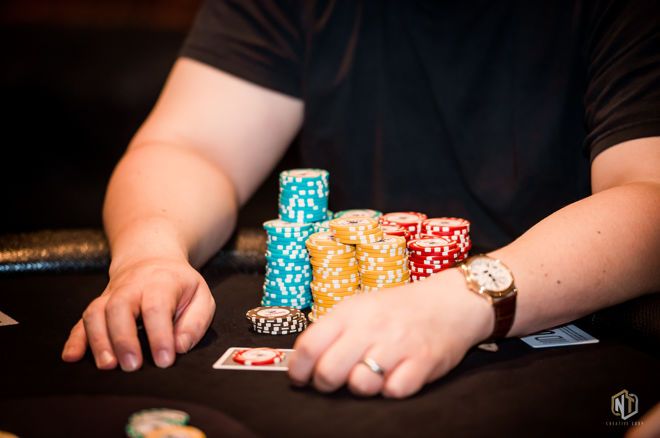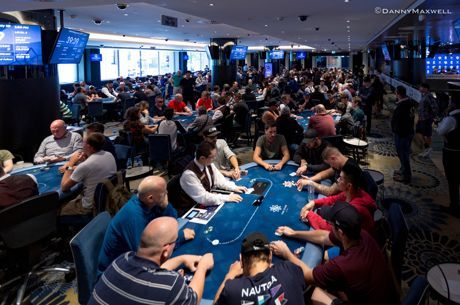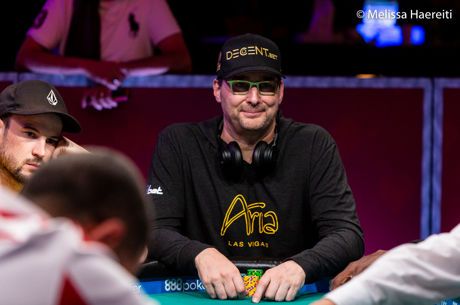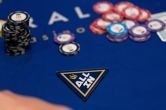The Kelly Criterion, Skill, and Patience

I learned about the Kelly Criterion from my professional blackjack player friends. The Kelly Criterion is a method for determining how much of your bankroll you should bet on a particular wager, given your edge in that wager. Here's an article about it.
Betting above Kelly puts you at risk of busting your bankroll. It should be obvious that betting a huge chunk of your bankroll on any one wager risks bankrupting you, even if you have the best of it every time. Winning blackjack players live and die by Kelly �� it tells them the limit of how much they should bet.
So, what does this have to do with poker? I routinely hear players say, "I have an edge here so I'm going with it." But they say that with little regard to the size of the edge or the effect of "going with it" on their financial security. I mean, suppose you were offered the chance to bet, at even money, that the roll of a fair die would turn up a number four or less. You'd jump at that, right? But wait. Suppose you were forced to wager $100,000, and your net worth was only $110,000? Would you jump now?
We all have a sense for how much is too much to bet.
Which brings me to yesterday. For the blissfully uninitiated, Big-O is pot-limit five-card Omaha, eight or better. I was playing in a Big-O game, there was a straddle on, a few players called, and an action player put in a full pot-sized raise. I looked down at a monster: A?A?2?5?10?.
This is the kind of hand Big-O players dream about. No poker analyst would object to my repotting it, even with the high likelihood that the action player will ship the rest in preflop. I didn't have Pro Poker Tools available at the time, but I did look it up later. If I give me A?A?2?5?10?, and I give my opponent a "top 30 percent" hand, I am a 62-to-38 favorite if we get all the money in preflop.
Well, if I had a six-foot stack of $100 bills and an opponent willing to go all in preflop with me having a 62-to-38 advantage all afternoon, I'd be quick to oblige. But I didn't have either, and that's worth investigating.
My opponent had me well covered, so if we went all in preflop and I lost, I'd go from "healthy profit" to "busto" in one hand. I had another couple of buy-ins in my pocket, but no desire to start all over again and try climb out of the hole. That would suck.
So I took the low variance route: I called his raise with my monster, instead of reraising. Then I whiffed the flop and folded at the first opportunity, with barely a depression in my profit cushion.
This serves me in two ways. First, I am not risking my ability to stay in a profitable game. With limited rebuys in my pocket, if my pocket bankroll goes to zero, I am out of the game and can no longer make money in it. It's my own private Kelly Criterion. I am limiting my bankroll exposure based on my edge in the wager.
Second, it decreases my stress level and lowers my blood pressure. Nobody likes going from way ahead to broke in one pot. Would it have affected my play if I'd gone all in and lost? Maybe. But it certainly would have killed my buzz for a while; I don't need that. I play poker for profit, sure, but mostly for fun. Some variance is part of the fun, but constant massive swings with tiny edges is not my idea of fun.
Another reason for not flipping is that I don't flip any better than the other guys. However, I think I do play better postflop poker than they do. So the more we flip, the better for them, as my edge is reduced to good starting hand selection (albeit an excellent edge from which to start). But when we battle in the postflop streets, I get to leverage that edge, too. Which brings me back to the Big-O game.
Over the next couple of hours, I saw a handful of flops, won a few small pots, lost a few. I was under my high-water mark when the big pot happened. I called a raise in a multi-way pot with a premium hand and flopped an uncounterfeitable nut-low draw with a 17-out straight wrap. I called a bet on the flop and caught the nut low on the turn. One opponent and I shoveled in all the money. As I suspected, I had the low locked up and was freerolling for the high. I hit the nut straight on the river and scooped the pot of the night.
As I was stacking, one of the regulars said, to no one in particular, "Lee Jones, he's a patient man." I took his comment as a compliment. When I'm playing my best game, I access my inner Kelly and try to shove big chunks of my stack into the middle when the going has gone from "good" to "great."
Want to get the money in really good? Check out Lee's coaching site at leejones.com/coaching to get a free consultation and see if his coaching is right for you.









